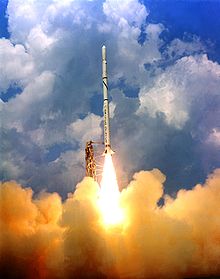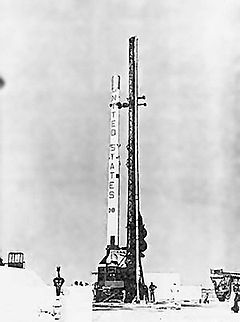
Scout (rocket)
Encyclopedia

Rocket
A rocket is a missile, spacecraft, aircraft or other vehicle which obtains thrust from a rocket engine. In all rockets, the exhaust is formed entirely from propellants carried within the rocket before use. Rocket engines work by action and reaction...
s were launch vehicle
Launch vehicle
In spaceflight, a launch vehicle or carrier rocket is a rocket used to carry a payload from the Earth's surface into outer space. A launch system includes the launch vehicle, the launch pad and other infrastructure....
s designed to place small satellites into orbit
Orbit
In physics, an orbit is the gravitationally curved path of an object around a point in space, for example the orbit of a planet around the center of a star system, such as the Solar System...
around the Earth. The Scout multistage rocket
Multistage rocket
A multistage rocket is a rocket that usestwo or more stages, each of which contains its own engines and propellant. A tandem or serial stage is mounted on top of another stage; a parallel stage is attached alongside another stage. The result is effectively two or more rockets stacked on top of or...
was the first (and for a long time, the only) orbital launch vehicle to be entirely composed of solid fuel
Solid rocket
A solid rocket or a solid-fuel rocket is a rocket engine that uses solid propellants . The earliest rockets were solid-fuel rockets powered by gunpowder; they were used by the Chinese in warfare as early as the 13th century and later by the Mongols, Arabs, and Indians.All rockets used some form of...
stages.
The original Scout (an acronym for Solid Controlled Orbital Utility Test system) was designed in 1957 at the NACA
NACA
- Organizations :* National Advisory Committee for Aeronautics, the forerunner of the U.S. federal agency NASA* National Association for Campus Activities, an organization for programmers of university and college activities...
Langley center
Langley Research Center
Langley Research Center is the oldest of NASA's field centers, located in Hampton, Virginia, United States. It directly borders Poquoson, Virginia and Langley Air Force Base...
. Scouts were used from 1961 until 1994. To enhance reliability the development team opted to use "off the shelf" hardware, originally produced for military programs. According to the NASA
NASA
The National Aeronautics and Space Administration is the agency of the United States government that is responsible for the nation's civilian space program and for aeronautics and aerospace research...
fact sheet:
... the first stage motor was a combination of the Jupiter Senior and the Navy PolarisUGM-27 PolarisThe Polaris missile was a two-stage solid-fuel nuclear-armed submarine-launched ballistic missile built during the Cold War by Lockheed Corporation of California for the United States Navy....
; the second stage came from the Army MGM-29 SergeantMGM-29 SergeantThe MGM-29 Sergeant was an American short-range, solid fuel, surface-to-surface missile developed at the Jet Propulsion Laboratory. Activated by the US Army in 1962 to replace the MGM-5 Corporal it was deployed overseas by 1963, carrying the W52 nuclear warhead or alternatively one of high explosives...
; and the third and fourth stage motors were designed by Langley engineers who adapted a version of the Navy VanguardVanguard rocketThe Vanguard rocket was intended to be the first launch vehicle the United States would use to place a satellite into orbit. Instead, the Sputnik crisis caused by the surprise launch of Sputnik 1 led the U.S., after the failure of Vanguard TV3, to quickly orbit the Explorer 1 satellite using a Juno...
.
The first successful orbital launch of a Scout, on February 16, 1961, delivered Explorer 9
Explorer program
The Explorer program is a United States space exploration program that provides flight opportunities for physics, heliophysics, and astrophysics investigations from space. Over 90 space missions have been launched from 1958 to 2011, and it is still active...
, a 7-kg satellite used for atmospheric density studies, into orbit.
The final launch of a Scout, using a Scout G-1, was on May 9, 1994. The payload was the Miniature Sensor Technology Integration 2 (MSTI-2) military spacecraft with a mass of 163 kg, which remained in orbit until 1998.
The standard Scout launch vehicle was a solid propellant, four-stage booster system, approximately 75 feet (23 m) in length with a launch weight of 47,398 pounds (21,500 kilograms.)
Scout A overview

- Thrust at liftoff: 513.40 kN (52,352 kgfKilogram-forceA kilogram-force , or kilopond , is a gravitational metric unit of force. It is equal to the magnitude of the force exerted by one kilogram of mass in a gravitational field...
) - Mass at launch: 17,850 kg
- Diameter: 1.01 m
- Length: 25.00 m
Scout A stages
Stage 1: Algol- Gross Mass: 11,600 kg
- Empty Mass: 1,650 kg
- Vacuum thrust: 564.25 kN (57,537 kgf)
- Burn time: 47 s
- Diameter: 1.01 m
- Span: 1.01 m
- Length: 9.09 m
Stage 2: Castor
Castor (rocket stage)
The Castor family of solid-fuel rocket stages and boosters were built by Thiokol and used on a variety of launch vehicles. They were initially developed as the second stage motor of the Scout rocket...
- Derived from Sergeant missile
- Gross Mass: 4,424 kg
- Empty Mass: 695 kg
- Vacuum thrust: 258.92 kN (26,402 kgf)
- Burn time: 37 s
- Diameter: 0.79 m
- Span: 0.79 m
- Length: 6.04 m
Stage 3: Antares
- Gross Mass: 1,400 kg
- Empty Mass: 300 kg
- Vacuum thrust: 93.09 kN (9,493 kgf)
- Burn time: 36 s
- Diameter: 0.78 m
- Span: 0.78 m
- Length: 2.90 m
Stage 4: Altair
- Gross Mass: 275 kg
- Empty Mass: 37 kg
- Vacuum thrust: 22.24 kN (2,268 kgf)
- Burn time: 28 s
- Diameter: 0.64 m
- Span: 0.64 m
- Length: 2.53 m
NASA use
In the late 1950s, NASA established the Scout program to develop a multistage solid-propellant space booster and research rocket. The U.S. Air Force also participated in the program, but different requirements led to some divergence in the development of NASA and USAF Scouts.The basic NASA Scout configuration, from which all variants were derived, was known as Scout-X1. It was a four-stage rocket, which used the following motors:
- 1st stage: Aerojet General Algol
- 2nd stage: ThiokolThiokolThiokol is a U.S. corporation concerned initially with rubber and related chemicals, and later with rocket and missile propulsion systems...
XM33 CastorCastor (rocket stage)The Castor family of solid-fuel rocket stages and boosters were built by Thiokol and used on a variety of launch vehicles. They were initially developed as the second stage motor of the Scout rocket... - 3rd stage: Allegany Ballistics LaboratoryAllegany Ballistics LaboratoryAllegany Ballistics Laboratory located in Rocket Center, West Virginia, is a diverse industrial complex employing some 1,000 people across...
X-254 Antares - 4th stage: Allegany Ballistics Laboratory X-248 AltairAltair (rocket stage)The Altair was a solid-fuel rocket with a fiberglass casing, initially developed for use as the third stage of Vanguard rockets. It was manufactured by Allegany Ballistics Laboratory as the X-248. It was also sometimes called the Burner 1.-Uses:...
Scout's first-stage motor was based on an earlier version of the Navy's Polaris missile motor; the second-stage motor was developed from the Army's Sergeant surface-to-surface missile; and the third- and fourth-stage motors were adapted by NASA's Langley Research Center; Hampton, VA, from the Navy's Vanguard missile.
Satellites that were put into orbit
- San Marco 1San Marco 1San Marco 1, also known as San Marco A, was the first Italian satellite, and one of the earliest non-Soviet/US spacecraft. Built in-house by the Italian Space Research Commission on behalf of the National Research Council, it was the first of five as part of the Italian-US San Marco programme.The...
, the first Italian satellite (in 1964), launched by an Italian crew. - San Marco 2, the second Italian satellite (in 1967) and first in the world launched from a sea platform. Three more San MarcoSan Marco programmeThe San Marco programme was an Italian-US satellite launch programme conducted between the early 1960s and the late 1980s. The project resulted in the launch of the first Italian-built satellite, San Marco 1, on December 15, 1964. With this launch Italy became the third country in the world to...
satellites would use Scout rockets. Italy owned San Marco platform launched in 1967-1984 Scout rockets only. - AEREOS and AEROS BAEROS (satellite)AEROS satellites were to study the aeronomy i. e. the science of the upper atmosphere and ionosphere, in particular the F region under the strong influence of solar extreme ultraviolet radiation...
atmospheric research - Ariel 3Ariel 3Ariel 3 was the first artificial satellite designed and constructed in the United Kingdom. it was launched from Vandenberg Air Force Base on May 5, 1967 aboard a Scout launch vehicle. Ariel 3 had an orbital period of approximately 95 minutes, with an apogee of 608 km and a perigee of 497 km...
- the first satellite designed and constructed in the United Kingdom, and four other ArielAriel space programmeAriel was a British satellite research programme conducted between the early 1960s and 1980s. Six satellites were launched as part of the programme, starting with the first British satellite, Ariel 1, which was launched on 26 April 1962, and concluding with the launch of Ariel 6 on 2 June 1979...
satellites including first satellite for radioastronomy - Ariel 2Ariel 2Ariel 2, also known as UK-C, was a British radio astronomy satellite, which was operated by the Science and Engineering Research Council as part of the Ariel programme. It was built in America by Westinghouse Electric, and had a mass at launch of...
. - MagsatMagsatMagsat spacecraft was launched in the fall of 1979 and ended in the spring of 1980. The mission was to map the Earth's magnetic field, the satellite has two magnetometers...
- The first globally complete 3D map of Earth's magnetic fields. - TransitTransit (satellite)The TRANSIT system, also known as NAVSAT , was the first satellite navigation system to be used operationally. The system was primarily used by the U.S...
satellites - A prototype satellite, Transit 5A, was launched 1962-12-19 by a Scout X-3. On four different flights, Scout rockets placed two Transit satellites in orbit with a single launch. The last of these, on 1988-08-25, launched Transit-O 31 and Transit O-25 on a Scout G rocket.
Scout designations
The Scout-X1 first flew successfully on 1960-10-10, after an earlier failure in July 1960. The rocket's first stage had four stabilizing fins, and the vehicle incorporated a gyro-based guidance system for attitude stabilization to keep the rocket on course.Some other Scout designations were:
- The Scout X-2 which in 1962 introduced the Antares IIB stage upgrade. On 1962-08-23 a Scout X-2 was used for the first successful launch of a DMSPDefense Meteorological Satellite ProgramThe Defense Meteorological Satellite Program monitors meteorological, oceanographic, and solar-terrestrial physics for the United States Department of Defense. The program is now run by the National Oceanic and Atmospheric Administration. The mission of the satellites was revealed in March 1973...
satellite, lifting off from Point ArguelloPoint ArguelloPoint Arguello is a headland used as a launch site by the United States Navy. Point Arguello was first used in 1959 for the launch of military and sounding rockets. It was transferred to the United States Air Force in 1964, at which time it became part of Vandenberg Air Force Base.There were 6...
near Vandenberg Air Force BaseVandenberg Air Force BaseVandenberg Air Force Base is a United States Air Force Base, located approximately northwest of Lompoc, California. It is under the jurisdiction of the 30th Space Wing, Air Force Space Command ....
. - The Scout X-3 which in 1963 introduced the Algol IIA upgrade.
- The Scout A-1 and B-1 which in 1965 introduced the Castor IIA and Altair III upgrades, respectively.
- The Scout D-1 which in 1972 introduced the Algol III upgrade.
- The Scout G flew from 1974 until the Scout's retirement in 1994. It was rated to orbit a 210 kg payload.
Military use — Blue Scout I
The USAF Scout program was known as HETS (Hyper Environmental Test System) or System 609A, and the rockets were generally referred to as Blue Scout. The prime contractor for the NASA Scout was LTV, but the Blue Scout prime contractor was Ford Aeronutronics.By using different combinations of rocket stages, the USAF created several different Blue Scout configurations. One of these was the XRM-89 Blue Scout I, which was a three-stage vehicle, using Castor 2 and an Antares 1A stages, but omitting the basic Scout's Altair 4th stage. The first launch of an XRM-89 occurred on 1961-01-07, and was mostly successful. On that flight, the XRM-89 carried a variety of experiments to measure rocket performance and high-altitude fields and particle radiation. The payload was located in a recoverable reentry capsule, but the capsule sank before it could be recovered from the water. The only other XRM-89 launches (in May 1961 and April 1962) were unsuccessful, and the Blue Scout I program was terminated in 1962.
Blue Scout II

The first XRM-90 launch occurred on 1961-03-03, followed by a second one on 1961-04-12. Both sub-orbital flights were successful, and measured radiation levels in the Van Allen belts
Van Allen radiation belt
The Van Allen radiation belt is a torus of energetic charged particles around Earth, which is held in place by Earth's magnetic field. It is believed that most of the particles that form the belts come from solar wind, and other particles by cosmic rays. It is named after its discoverer, James...
. The second Blue Scout II also carried a micrometeorite sampling experiment, but the recovery of the reentry capsule failed. The third XRM-90 was used by NASA in November 1961 for Mercury-Scout 1
Mercury-Scout 1
Mercury-Scout 1, or MS-1, was a United States spacecraft intended to test tracking stations for Project Mercury flights. It grew out of a May 5, 1961 NASA proposal to use Scout rockets to launch small satellites to evaluate the worldwide Mercury Tracking Network in preparation for manned orbital...
. This was an attempt to orbit a communications payload for Project Mercury
Project Mercury
In January 1960 NASA awarded Western Electric Company a contract for the Mercury tracking network. The value of the contract was over $33 million. Also in January, McDonnell delivered the first production-type Mercury spacecraft, less than a year after award of the formal contract. On February 12,...
, but the rocket failed after 28 seconds of flight. The USAF subsequently abandoned the XRM-89 Blue Scout I and XRM-90 Blue Scout II vehicles, and shifted to the RM-91/SLV-1B Blue Scout Junior instead.
Blue Scout Junior

The first launch of an XRM-91 occurred on September 21, 1960, making it actually the first Blue Scout configuration to fly. The flight was planned to make radiation and magnetic field measurements at distances of up to 26 700 km (16 600 miles) from earth, and while the rocket did indeed achieve this altitude, the telemetry system failed so that no data was received. The second launch in November ended with a failure during second stage burn. The third flight was to measure particle densities in the Van Allen belts and reached a distance of 225 000 km (140 000 miles), but again a telemetry failure prevented the reception of scientific data. The fourth and final XRM-91 mission in December 1961 also carried particle detectors, and was the only completely successful flight of the initial Blue Scout Junior program.
The Blue Scout Junior was regarded by the USAF as the most useful of the various Blue Scout configurations. It was used (in slightly modified form) between 1962 and 1965 by the Air Force as the SLV-1B/C launch vehicle for suborbital scientific payloads. The SLV-1C was also chosen as the rocket for the MER-6A interim ERCS (Emergency Rocket Communications System
Emergency Rocket Communications System
The Emergency Rocket Communications System was a back-up communications method for the United States National Command Authority, using a UHF repeater placed atop a Blue Scout rocket or Minuteman II intercontinental ballistic missile. ERCS was deactivated as a communication means when President...
) vehicle. NASA used a three-stage Blue Scout Junior configuration (omitting the Cetus 4th stage) as the RAM B.
External links
- Profile of the Blue Scout Junior
- Specifications and chronology of the Scout series

